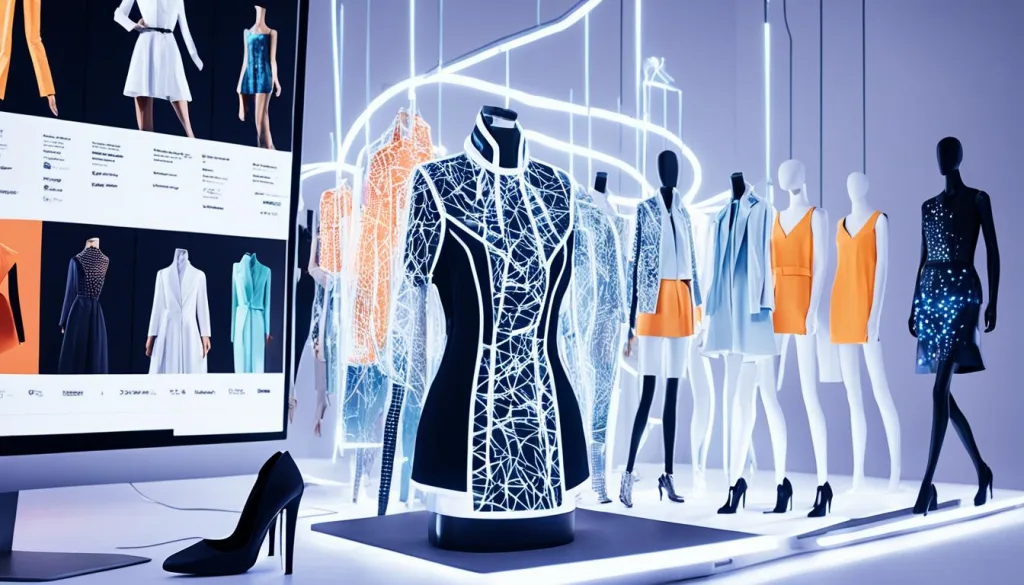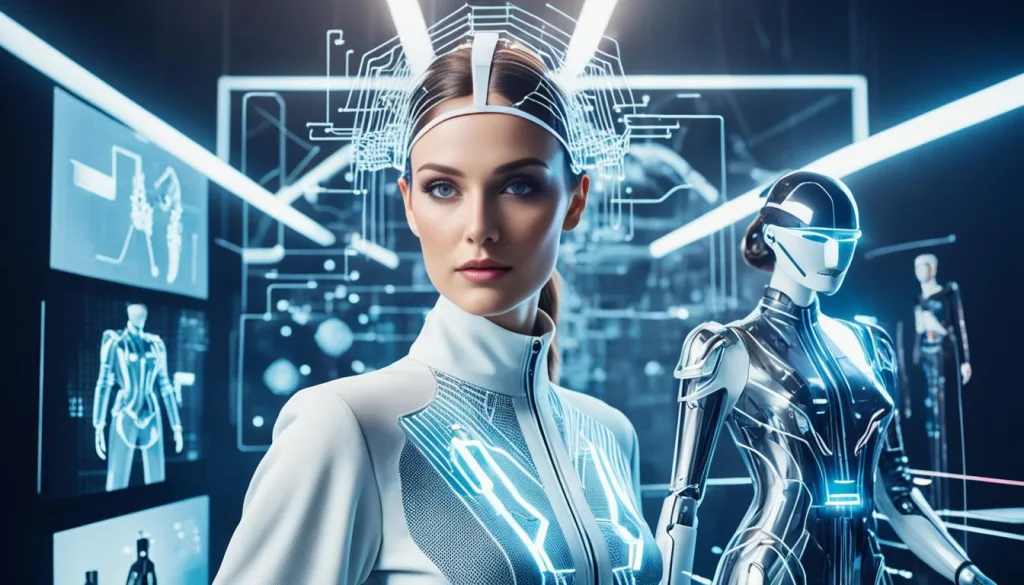Artificial Intelligence in Fashion Forecasting and Trend Analysis
Connect With Us Today
Consider us for your next production run. Why wait? Send us your questions here.
The global fashion industry is worth about $2tn and is experiencing a tech makeover1. With artificial intelligence and machine learning, fashion forecasting is becoming more accurate. This change helps solve a big problem – 40% of clothes don’t sell at full price1. By predicting what people will want to wear, brands can plan better and reduce waste1.
Using AI for fashion predictions means we can also cut down on the environmental impact. This is crucial as fashion is responsible for 4% of the world’s emissions. Smarter planning leads to less unnecessary production1.
Key Takeaways
- Artificial Intelligence in Fashion Forecasting and Trend Analysis is revolutionizing trend prediction and market analysis.
- Machine Learning in Fashion Forecasting offers dynamic solutions to address the problem of inventory surplus.
- AI-driven Fashion Trend Prediction helps brands to respond swiftly to evolving consumer preferences.
- Fashion Industry AI Trends suggest a more sustainable and efficient management of the production cycle.
- Predictive Analytics in Fashion Forecasting enable a year-ahead view of changing consumer tastes and market demands.
- AI Technology for Fashion Trends assists in identifying latent trends from diverse demographic data sets previously unexplored.
- Fashion Prediction Models powered by AI are essential tools for enhancing market trend visibility and tailoring collections to emerging patterns.
The Evolution of Fashion Forecasting and the Advent of AI
The fashion industry, now worth about $2 trillion worldwide1, has seen big changes in how trends are predicted. The old ways, focused on runway shows, are fading. The Advent of AI in Fashion Forecasting marks a new era. It combines past sales, inventory levels2, and live data. This helps align designs with what people want, foresee sales, and shape the future of Evolution of Fashion Forecasting.
From Runway Shows to Real-Time Data

Looking into the shift from Runway Shows and Fashion Trends, we can see a big change. AI now studies millions of social media posts each day1. It spots new trends in pictures, social media, and sales figures1. Gone are the days of just watching the seasons change on runways. Now, companies like Heuritech use over 2,000 features to track trends1.
The Shift from Traditional to AI-Driven Forecasting
Old-school forecasting methods are being replaced by AI-Powered Trend Analysis. They can predict trends up to a year ahead1. This shift is making the industry more efficient and reducing waste. AI helps in choosing what stocks to keep, cutting costs, and lessening environmental harm21. Yet, there’s concern that AI might take away jobs in design and marketing2.
Understanding the Dynamics of AI-Powered Trend Analysis
Exploring AI-Powered Trend Analysis, we find amazing predictive skills. AI is key to making fashion more diverse and creative, focusing on specific groups1. However, there’s fear that designs might become too similar due to algorithms2. Still, AI could boost the fashion industry’s profits by up to $275 billion in the next few years3.
As AI becomes more involved in fashion forecasting, the industry is at a turning point. It’s finding the right mix of efficiency and creativity. Market leaders like McKinsey foresee big gains for brands using AI creatively3. The future of fashion is shaped by algorithms, starting a thrilling new chapter for the industry. This is an era of digital threads in the world of fashion forecasting.
Artificial Intelligence in Fashion Forecasting and Trend Analysis
AI in Fashion Forecasting is changing the game in Fashion Trend Analysis Using AI. It uses predictive analytics to drive innovation and sustainability in fashion. By analyzing big data, AI Technology for Fashion Trends can predict future currents. It also improves the shopping experience for customers4. Virtual try-on tech shows AI’s power to change things. It lets shoppers see how clothes look on them easily. This increases their happiness and lowers the chance things are returned4.

AI also enhances the fashion industry’s backend, like AI optimizing supply chain processes. This leads to less waste and better inventory control4. Not just logistics, even design benefits from AI. Designers get new creative tools from AI, like Generative Adversarial Networks and Style Transfer Models4.
The way we predict fashion trends with AI has changed a lot. Now, machine learning looks at social media and past sales for quick, real-time insights. This catches changes from viral trends fast and affects what people buy5. Digitally native brands show how this new approach works. They use special social media content to connect with customers and beat old retail ways5.
But, the fashion industry is big on culture and has a big environmental impact. So, using AI for eco-friendly practices is key. AI’s forecasts could cut down on overproduction, which leads to too many clothes sold at discount or not sold at all1. AI also works with human creativity. It’s important to find the right mix of data-based predictions and fashion’s creative values1.
With AI’s deep analysis and predictive precision, the fashion industry stands on the brink of a new era—where trend prediction goes beyond mere speculation, grounded in a data-rich understanding of past, present, and evolving consumer behavior.
Machine Learning’s Role in Shaping Future Fashion Trends
The fashion world, worth about $2tn1, is at a crucial point. Machine Learning in Fashion Forecasting is key to reducing the industry’s environmental impact, which includes 4% of global emissions1. By using ML for trend prediction, the industry aims to cut down on the 92 million tonnes of fabric waste it produces each year1.
It also helps reduce overproduction, where 40% of clothes are not sold at full price and 25% are never sold1. Brands are now using Predictive Analytics Enhanced by Machine Learning to better meet consumer demands. This approach helps align products with trends and cut down on waste, improving sustainability.
At the heart of change, Decoding Consumer Preferences with Machine Learning is crucial for brands to understand consumer behavior6. This approach blends internal data with vast external data, changing how collections are created and personalized6. This blend leads to highly accurate trend forecasts.
How Machine Learning Decodes Consumer Preferences
Machine Learning algorithms analyze data to identify consumer likes. Using first-party and third-party data, the fashion industry can target customers better and manage stock more effectively6. It uses past performance and analytic diagnostics to meet consumer needs effectively, creating a successful strategy for trend prediction6.
Enhancing Predictive Analytics in Fashion with ML
Predictive analytics help foresee future trends. Prescriptive analytics, boosted by AI and big data, offer steps to achieve predicted results6. This knowledge lets the fashion industry keep up with trend changes wisely. It also cuts down the risks linked with inventory and trend guesses.
Machine Learning plays a big role in making fashion more sustainable16. It helps industries stock up on trends consumers want, which reduces waste and increases efficiency. This showcases ML’s vital role in making fashion forecasting greener.
Using Predictive Analytics Enhanced by Machine Learning changes how the industry works1. ML helps prevent overproduction and lessen unsold items. This makes the fashion industry more sustainable, keeping it profitable and responsible towards the environment.
Identifying Emerging Trends with AI Technology
The global fashion industry is worth about $2 trillion. It struggles to stay ahead in a fast-changing world and also deals with a huge carbon footprint. This industry creates at least 4% of the globe’s emissions1. Artificial Intelligence is now a game-changer in spotting fashion trends early on. It can predict trends a year ahead and noticed a big rise in pinstripes in Europe by 80%, showing how important AI is for spotting new trends1.
AI tools don’t just predict trends but also cut down on waste, which is over 92 million tonnes of fabric each year. And more than a quarter of products never get sold1. AI helps designers create collections that match what people want more closely. This makes the fashion business more efficient and profitable. By analyzing millions of social media posts daily, AI helps the industry offer a wider variety of collections and reach new customers1.
Gen-Z shoppers, who make up 75% of the customer base, prefer sustainable brands over famous names. They like products made just for them. This leads 56% of customers to buy again7. Big brands like Mango have made 15 AI models since 2018. These models help with pricing and improving the shopping experience7. AI could help the fashion industry grow its profits by $150 to $275 billion in the next few years7. Bringing AI into fashion starts a new era where new meets old. And using AI wisely promises a future of being efficient, welcoming, and caring for the planet.
FAQ
How is artificial intelligence being used in fashion forecasting and trend analysis?
What role does machine learning play in shaping future fashion trends?
How can AI technology identify emerging fashion trends?
Source Links
- https://www.theguardian.com/technology/2023/oct/01/ai-artificial-intelligence-fashion-trend-forecasting-style
- https://www.forbes.com/sites/theyec/2023/02/21/artificial-intelligence-in-fashion/
- https://www.mckinsey.com/industries/retail/our-insights/generative-ai-unlocking-the-future-of-fashion
- https://newo.ai/insights/ais-impact-on-fashion-forecasting-and-trend-analysis/
- https://www.heuritech.com/trend-forecasting-fashion-ai/
- https://www.oracle.com/retail/fashion/fashion-analytics/
- https://www.forbes.com/sites/forbestechcouncil/2023/11/06/why-the-fashion-industry-cant-ignore-ai-five-key-trends-to-watch/
Latest News
How Collaboration Shapes Consumer Preferences in Sportswear
Navigating Consumer Rights and Warranties in Sportswear Sales
Artificial Intelligence in Fashion Forecasting and Trend Analysis
The Shift Towards Inclusive Sizing in Sportswear: Consumer Reactions
The Global Expansion of Luxury Sportswear Brands
From Sketch to Gym: The Design Process of Fashionable Sportswear
Understanding the Role of Trade Associations in Sportswear Compliance
How Economic Trends Influence Consumer Spending on Sportswear
Learning from Successful Global Market Entries
Best Practices for Managing Cross-Cultural Teams
Using Technology to Fight Counterfeit Fashion Products
Carbon Nanotube Fabrics for Superior Strength and Flexibility
The Growth of Fitness Tracking Apparel in Health and Wellness
Exploring the Influence of Social Proof in Sportswear Purchasing
Strategies for Managing Compliance in a Multinational Operation
Trends in Global Footwear: Performance Meets Lifestyle
The Role of Artificial Intelligence in Tracking Supply Chain Operations
Evaluating the Success of Sportswear Collaborative Projects
Evaluating the Potential of Emerging Markets
Global Shifts Towards Gender-Neutral Sportswear
Share This Article
Latest Articles



















